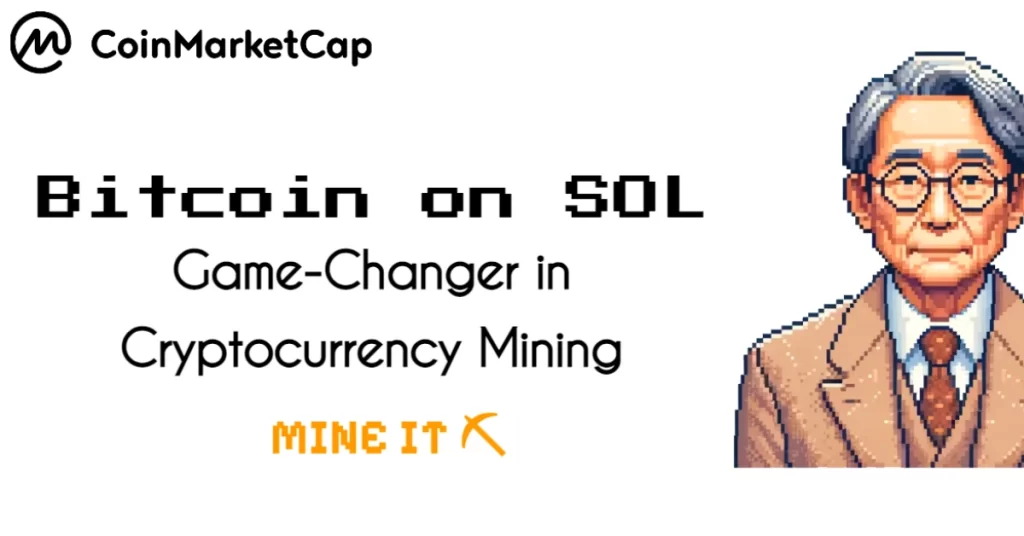
The post Bitcoin on SOL: A Game-Changer in Cryptocurrency Mining appeared first on Coinpedia Fintech News
In the innovative landscape of blockchain technology, Soltoshi Nakamoto’s “Bitcoin on SOL” project marks a paradigm shift in cryptocurrency mining, intertwining the original ethos of Bitcoin with cutting-edge blockchain technology. This project uses the traditional Proof-of-Work (PoW) model, introducing an innovative approach by incorporating Non-Fungible Tokens (NFTs) and the Solana blockchain’s efficiency. It’s a journey back to Bitcoin’s roots, albeit with a modern twist, aiming to democratize mining and enhance network performance.
The Fusion of Solana and NFTs in Mining
Innovative Mining Concept: The cornerstone of this project is the shift from traditional, power-intensive mining to a novel system where Non-Fungible Tokens (NFTs) on the Solana blockchain play a central role. This approach democratizes the mining process, making it accessible and less reliant on massive computational resources.
Mining with NFTs: Each NFT contributes a fixed hash rate, democratizing the mining process. A cap of 10,000 NFTs ensures a balanced and decentralized system, preventing the dominance of a single entity and promoting network security.
Enhanced Network Capabilities
Quicker Block Times: By reducing the block time to 5 minutes, the project significantly improves transaction speed and network responsiveness. This enhancement is crucial for adapting Bitcoin mining to the demands of today’s digital economy.
Accelerated Halving Schedule: The project introduces a faster halving event, occurring every 42,000 blocks. This change not only heightens the scarcity of Bitcoin but also has the potential to increase its value, presenting an intriguing economic dynamic.
Reward Mechanism and Economic Incentives
The Mining NFT/ NFT Pool that solves the block first gets the mining reward, starting at 50 BTC and halving every 42,000 blocks.
Competitive Reward System: The protocol starts with a 50 BTC block reward, maintaining the original incentive of Bitcoin mining. The first mining pool to solve the block earns the reward, fostering a competitive environment that rewards efficiency.
Economic Model: This unique structure, combining NFT-based mining with an accelerated halving schedule, incentivizes early participation and promises a rapidly appreciating value for Bitcoin as the supply contracts.
Security and Network Efficiency
Guarding Against Attacks: The distribution of mining power through a limited number of NFTs inherently protects against risks like the 51% attack, enhancing the overall security and stability of the network.
Adaptive Network Design: The system’s ability to swiftly adjust to changes in mining activity and network conditions is a testament to its efficiency and responsiveness, which are crucial for maintaining a consistent mining rate and network health.
Practical Guide to Mining BTC on SOL
Getting Started with Mining: To engage in mining, one must acquire a mining computer represented by a Solana NFT, available through specific platforms. This NFT ownership is essential for participation in the mining process.
The Mining Experience: The project offers a dynamic mining environment, with blocks being solved approximately every 5 minutes. Each mining rig has a chance to win the reward regardless of the hash power which is chosen at random by the smart contract. But if you hold more NFTs, then you have more probability of getting rewarded. You can check the estimated change of being rewarded per NFT here.
Pricing Strategy for NFT Mining Rigs
The “Bitcoin on SOL” project implements a strategic pricing model for its NFTs to maintain value over time. For every 385 NFTs minted, the price doubles from the current rate at the article’s publication.
This approach rewards early adopters, enhances market stability, and encourages prudent investment decisions. It aligns the NFTs’ value with market demand, avoiding speculative volatility. This pricing structure is pivotal in balancing accessibility with investment potential, crucial for the project’s goal of democratizing cryptocurrency mining and establishing a sustainable digital asset ecosystem.
NFT Mining vs. Traditional Mining
Energy and Cost Efficiency: Traditional mining is characterized by its intensive energy consumption and high operational costs, primarily due to the need for sophisticated and power-hungry mining rigs. “Bitcoin on SOL” disrupts this model by leveraging NFTs, drastically reducing the energy footprint and operational costs associated with mining. This shift not only makes the process environmentally friendly but also significantly more cost-effective.
Accessibility and Democratization: The conventional mining approach, demanding substantial investment in hardware, has been a barrier to entry for many. Soltoshi Nakamoto’s approach democratizes the mining process by allowing individuals to participate by acquiring NFTs. This method lowers entry barriers, making mining more accessible to a broader audience.
Reduced Hardware Dependency: Traditional mining necessitates continual investment in physical hardware and its maintenance. “Bitcoin on SOL” circumvents this requirement, as the mining power is associated with digital NFTs rather than physical hardware, leading to reduced logistical complications and maintenance costs.
Network Security and Decentralization: Traditional mining has faced criticisms of centralization, where larger pools dominate the network. “Bitcoin on SOL” addresses this by capping the number of NFTs, hence the number of miners, enhancing network security and maintaining decentralization, a core tenet of blockchain technology.
Enhanced Network Capabilities
Faster Transaction Processing: By reducing block time to 5 minutes, “Bitcoin on SOL” enhances the network’s transaction processing capabilities, making it more suited for the digital economy’s demands.
Scarcity and Value: The project’s accelerated halving schedule, occurring every 42,000 blocks, amplifies Bitcoin’s scarcity, potentially driving up its value. This innovative economic model balances immediate miner incentives with long-term currency valuation.
Economic Incentives and Scalability
Rewarding Efficiency: The protocol’s design rewards efficiency and technological advancement by allocating block rewards to the fastest-solving pool, encouraging innovation in mining strategies.
Scalable and Sustainable Model: Leveraging Solana’s blockchain for NFTs brings scalability and efficiency, offering a sustainable model for future growth, both in terms of network capacity and environmental responsibility.
How to Mine BTC on SOL: A Detailed Guide
Step 1: Set Up Your Mining Wallet
Mining Wallet: Download and set up your Solana wallet to link your NFT to the mining network. Ensure you have a Solana wallet that supports NFTs and connect it to a mining platform such as Phantom Wallet.
Step 2: Acquire a SOL Mining NFT
Where to Obtain: Begin by obtaining a mining computer in the form of a Solana NFT. These can be purchased through platforms like mine.sol-btc.xyz, and secondary markets such as Tensor, OKX, and Magic Eden.
Step 3: Start Mining
Monitoring: Buy and just leave your mining rigs to the same wallet you want to receive your rewards on. Regularly monitor your mining activity and performance. Stay informed about network changes, such as difficulty adjustments and halving events.
Step 4: Earning and Managing Rewards
Reward System: Understand the reward system, where the mining pool that solves the block first earns the reward.
Managing Earnings: Rewards are distributed in BTC. Manage your earnings by transferring them to a secure wallet or reinvesting in additional mining NFTs.
Step 5: Participate in the Community
Stay Informed: Engage with the “Bitcoin on SOL” community for updates, support, and strategies.
Contribute: Share your experiences and strategies to help evolve the mining process and support the network.
The Future of Mining with “Bitcoin on SOL”
Soltoshi Nakamoto’s Vision: The visionary approach of Soltoshi Nakamoto in “Bitcoin on SOL” redefines the landscape of cryptocurrency mining. By integrating NFTs into the mining process, it not only upholds the principles of decentralization but also addresses the pressing issues of environmental sustainability and equitable access.
Practical Mining Guide: Engaging in this new mining process involves acquiring a mining NFT, which opens the door to participating in a more dynamic, efficient, and rewarding mining ecosystem.
Conclusion
Soltoshi Nakamoto’s “Bitcoin on SOL” project marks a significant milestone in the evolution of cryptocurrency mining. It harnesses the power of NFTs and the efficiency of the Solana blockchain to create a mining ecosystem that is not only more sustainable and cost-effective but also more inclusive and secure. This innovative approach could very well set a new standard for cryptocurrency mining, shaping the future of decentralized digital currencies.
Disclaimer: This project is an experimental endeavor to expedite Bitcoin’s processes on the Solana blockchain. Note that the current circulating supply is under 300K tokens, with the remainder to be mined over time. This initiative aims to replicate the Bitcoin experience and explore outcomes post-full mining, a scenario only feasible on Solana.

 1 year ago
113
1 year ago
113














 English (US) ·
English (US) ·